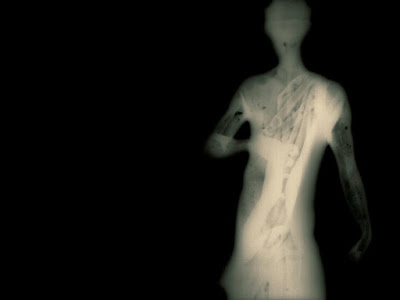Self Portraits (Medicalised) At Age
Twenty-Six
Through
portraiture, drawing and digital media, Self
Portraits (Medicalised) At Age Twenty-Six investigates medicalised-imaging
and images of the self as an enquiry into the seen and unseen aspects of the
human body. By disrupting tropes of Renaissance portraiture and associated
conventions, this series imitates classic poses from self-portraits to question
notions of the classic beauty and the contemporary digital portrait. Through the
introduction of medical imaging upon these images, it also poses an enquiry
into medical interventions upon the human body and the indistinct medicalised imprint
that is created from these interventions.
Self Portraits (Medicalised) At Age
Twenty-Six is a series of
six layered works that sit upon light boxes. By appropriating the poses seen
within the self-portraits of Albrecht Durer, four photographs were created as
base layers. Layered upon these portraits are collages of medical imaging combined
with hand and digital drawing. This re-invention of the image is a means to find new pathways to discuss
the effects of medicalisation.
The
portraits I have appropriated are from various stages of Durer’s life and the title
of this series is a response to Durer’s work, copying the layout of his
self-portrait titles. Durer depicts certain poses that uphold the classical
ideals of portraiture from the Renaissance. By mimicking these poses I seek to
follow in his footsteps, constructing my image as someone worthy of being
represented in a portrait. In each of these portraits Durer is dressed
opulently, his hair a prominent feature. Careful planning went into each aspect
of his portraits and through my costuming I attempt something similar. The
green outfit is representative of a medical gown, similar to the ones worn into
surgery, while the other poses are my usual clothing but presented in a
classical way. Durer’s hair is a key feature of his character and, as I closely
associate my hair with my own identity, I have accentuated the bright purple in
it.
These
self-portraits explore my lived experience, investigating the effects of
medicalisation upon the human body and identity. Societal stigmas surrounding
mental and chronic illness are still prevalent today. In considering that is
easy to doubt issues that cannot be seen, to question their existence, and chronical
illness is often disregarded.
Presented
in a series, on top of light boxes, each self-portrait is a layered work. This brings
our visual attention to the invisible illness by revealing the medical imaging
of x-rays and ultrasounds through photographic portraits. David Maisel x-rays
historical art objects in his own practice states that:
“The x-ray has historically been used for the
structural examination of art and artefacts much as physicians examine bones
and internal organs; it reveals losses, replacements, methods of construction,
and internal trauma that may not be visible to the naked eye.”
In
considering my personal illnesses as invisible, the ‘internal trauma’ is
hidden, however, the external, physical effects are visible. The use of medical
imaging documents illnesses as a ‘construction’ of the real. It records the
truth of our bodies and exists as evidence as validation of lived experience.
Through the collision of digital drawing, collage and the mimicked classical
portraits, I reference the clinical aspect of medical imaging and the
beginnings of my own personal experience of medicalisation as a young woman.
The white light behind the image makes viewing layers possible, enabling us to
see what lies beneath the surface.
In Reach
(2000) and Trap - self portrait (1998) Justine Cooper
explores medical imaging and her own translation of the self through this
technology. She had MRI scans taken of different parts of her body and explores
a restructuring of her body through this technology. Cooper writes:
“At the point of imaging, solid organic tissue
is transposed into an ephemeral digital language of zeroes and ones, in much
the same way that a cipher uses substitution to encrypt information. In the
resulting physical work I attempt to retain some of the ephemerality of that
earlier translation into digital space, some of the obscurity of the cipher,
while offsetting them against the apparent tangibility of the body. Instead of
a simple dichotomy between invisible and apparent, virtual and physical,
continuity and displacement, an attempt at a less distinct or concrete
disclosure is being made where the gap becomes the viewer's space.”
Medical
imaging creates a digital language through which the body is understood and through
the digital collaging of my own scans, a ghostly, figurative image of my
physical body is created. It is an echo of the original image, a ghostly
dismembered body that forms a self-portrait in a new language. The scanned
collages continue to inform the original portrait and the portrait continues to
update the scans and thus a feedback loop is generated with each system of
seeing and understanding the body, informing the other.
This
series proposes that what is seen on the surface is not always representative
of the truth and it invites the viewer to look beyond the surface of the skin.
There can be a true disconnect between our physical body and our own sense of
self. By rupturing and designing images
through collage using medical imaging, photography and hand and digital drawing
this enquiry is realised.






















